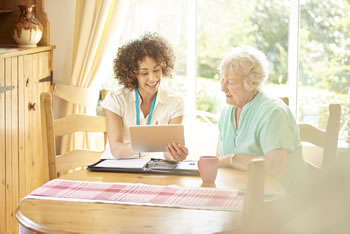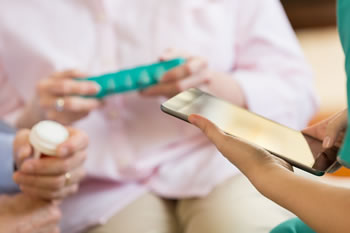With more seniors wanting to remain in their homes as they age — even during health challenges — emerging mobile health (mHealth) technology is making it happen. Home health agencies can leverage these new tools to improve the services they provide and help clients and their families take a proactive role in seniors’ health and safety.
 mHealth, defined by the World Health Organization as medical and public health practice supported through mobile and wireless devices, can support people of all ages. But today’s senior citizens are perhaps best able to take advantage of today’s mobile technology to improve their health and benefit from in-home health care.
mHealth, defined by the World Health Organization as medical and public health practice supported through mobile and wireless devices, can support people of all ages. But today’s senior citizens are perhaps best able to take advantage of today’s mobile technology to improve their health and benefit from in-home health care.
mHealth Innovations That Help Seniors Remain Safe and Healthy at Home
Nearly 90% of today’s individuals aged 65 and older wish to age in place, but it can be challenging to ensure their homes are a safe place in which to do so. New mHealth technologies, like those described below, can help create this security and enable their care teams to accommodate their complex health care needs, which in turn enables them to remain where they feel most comfortable.
GPS
GPS is more than a trusted method of getting from Point A to Point B; it can also provide a sense of security for seniors (and their families). Wearable pendants like the Phillips Lifeline GoSafe provides GPS-enabled tracking that lets emergency personnel easily locate seniors in the event of an at-home emergency or when they need assistance outside the home.
Remote Monitoring Tools
Remote monitoring tools are giving many seniors the opportunity to remain in their homes while letting care providers or family members monitor daily behavior.
Sensors placed around a client’s home — such as on doors, windows, and appliances — can identify specific events, such as when a client misses a meal or leaves the house, and will notify selected personnel about these events.
The Lively safety watch, for example, has passive activity sensors that can be attached to moveable objects around a senior’s home to detect such daily activities as when a door is opened or medication is taken. The device compares this activity against historical data to identify pattern abnormalities and alert family members or caregivers to the change. Similarly, the Good Samaritan Society uses a variety of sensors to detect when toilets have been flushed or the amount of movement in a room.
Meanwhile, wearable monitors can track vital signs, physical activity, sleep patterns, and glucose levels. They can also provide medication reminders and even detect dangerous behavior (like falls or inactivity) and call for assistance.
Remote monitoring tools can reduce the number of doctor visits the senior must make while also assuring family and caregivers of a client’s safety. And by offering a comprehensive view of health patterns over time, these devices can spur providers to update care plans if they notice concerning changes to the client’s everyday routine.
Mobile Medical Apps
A wide range of mobile applications designed for seniors, their families, and their caregivers can help improve communication and care while enabling caregivers to work with clients as efficiently as possible. Some of the most common types of medical apps include:

- Reminder apps help patients remember medications, appointments, and more; they can also alert clients to schedule upcoming appointments or make changes to care plans.
- Emergency apps let a client simply press a button to automatically notify predetermined contacts of potential emergencies.
- Medical apps allow patients to communicate with providers, make appointments, view test results, refill prescriptions, and more.
Additionally, although not strictly medical in nature, social media apps can help housebound patients remain in contact with friends and family. From offering photo sharing and interactive games to messaging, these apps keep patients active and engaged.
mHealth Trends That Are Changing the Way Agencies Deliver Care to Seniors
While mhealth technology is helping seniors safely remain in their homes as they age, it’s also transforming the ability of agencies to be efficient and effective with the services they provide.
Mobile devices in a home care setting can do far more than simply enable caregivers and clients to make calls. Today’s smart phones are now powerful minicomputers that can fit in one hand yet store a wealth of information that can aid on-site care.
As a result, mobile apps that are part of a comprehensive Mobile Health Solution can give caregivers in the field multiple important components, including up-to-date patient information and schedules, point-of-care documentation, Electronic Visit Verification, GPS-based mileage calculations, caregiver location visibility, secure messaging, and secure broadcast messaging.
Improved On-Site Access to Visit and Client Data
Caregivers can also enter visit data at the point of care instead of waiting until after the visit to complete paperwork at the agency, which significantly improves the accuracy of documentation.
There’s an efficiency component as well. GPS-based mileage tracking and Electronic Visit Verification automates the process of recording travel and time in/time out. This saves time and hassle for the caregiver, reduces mileage reimbursement expenses for agencies (one agency saw mileage costs reduced by 26% versus self-reporting), and improves agency compliance with EVV mandates.
Additionally, the ability for caregivers to quickly access up-to-date schedules reduces the risk of late or missed visits.
Improved Agency-Caregiver Communication
When caregivers are always on the move, it’s important that agency staff can quickly and securely communicate with them when needed.
A secure messaging system will enable individual caregivers to stay connected with their agency throughout the day. Agency staff can message the caregiver with changes to schedules and care plans, or any other important communication that may be needed throughout the day. This improves caregiver responsiveness, facilitates collaboration across care teams, increases both caregiver and client satisfaction and eliminates the need to purchase a separate secure messaging solution.
The ability to quickly communicate to an entire field of caregivers is also critical. Secure broadcast messaging — with message tracking — through a robust Mobile Health Solution enables agencies to easily push out essential information to all caregivers, such as:
- Upcoming team meetings
- Public safety announcements, like flu epidemics or weather emergencies
- Changes to schedules and shifts to improve coverage
As the nation’s senior population rises dramatically — those older than 65 are projected to make up 20% of the population by 2050 — more seniors are choosing to age at home.
Although not every individual is a candidate for in-home care, the evolution of mHealth technology is helping a greater percentage of this population remain safely at home by enabling activity, vital statistics, and changes to behavior patterns to be easily monitored — all while enabling home care agencies to deliver the most efficient and effective care possible for these clients.
CellTrak is simplifying the delivery of care with its Mobile Health Solution — improving home care agencies’ ability to provide quality care while keeping clients comfortably at home. Download our white paper to find out how to evaluate your options and choose a solution that’s right for your agency.
